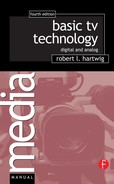Traditional editing limits flexibility.
Problems of Traditional Editing
Although SMPTE time code and computerized editors have greatly enhanced the editing process, there is a problem that limits flexibility and creativity in traditional editing, particularly in off-line editing. Once you have edited a sequence of scenes together, you cannot go back and change one of those scenes without reediting the entire tape from that point on. Assume, for example, that you had edited a tape with four scenes in it. After looking at the tape several times, you decide that the tape would be much better if the second scene started two seconds earlier. That will make the second scene and the tape two seconds longer. If you go back and reedit that scene and include the extra two seconds, the new scene will overlap and blank out the first two seconds of the third scene. As a result, you will have to reedit the third scene, which will now overlap the fourth scene. So you will have to reedit that. If you were to take that second scene and cut it down by two seconds, instead of adding two seconds, there would be unwanted material on the tape between the end of the new scene two and the beginning of scene three. So, again, the tape would have to be reedited from the new end of scene two. Imagine how much more complex and time consuming the problem would be if you had to make a change early in a half-hour program that had 45 or more edits. This traditional process is called linear editing and, as you can imagine, is very time consuming. Since you will be renting the editing suite, that additional time translates into an increased expense.
One advantage of off-line editing is that it allows you to go through this process and develop an EDL using relatively inexpensive small-format equipment. Imagine how much more time and money could be saved if you did not have to go back and completely reedit a tape after changing a scene.
Since the beginning of videotape editing in the early 1970s, engineers have been trying to devise editing systems that would allow you to make changes wherever you want without requiring you to go back and reedit the entire piece. Those systems were developed in the mid-1990s. They will be discussed next.
Problems of reediting a tape using traditional methods.

